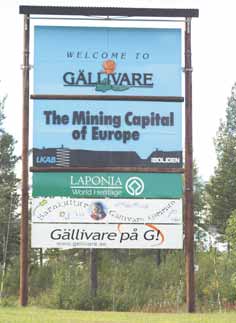
Gällivare in Sweden: proud of its mining past and
present, hopeful for the future.
Polar Bulls Plan on a Long-Term Future
AITIK 36: How Boliden is Doubling Capacity
The Gällivare community in Sweden
certainly has two world-class mines on
its patch north of the Arctic Circle to
back its claim as the mining capital of
Europe. Perhaps more important for
Boliden and LKAB is the implied civic
pride in mining. While LKAB employs
some 1,000 of the town’s 20,000 population
at the Malmberget operations
and Boliden a further 500 at Aitik, the
varied recreational facilities in the area
are a growing sector of the local economy.
Having support for the expansion of
the mines to maintain employment is
presumably helpful when applying for
the necessary permits.

Aitik started life in 1968 producing 2 million mt/y copper ore from reserves of 50 million mt. It has since produced in excess of 450 million mt copper ore thanks to a series of expansions in 1970–72 (to 6 million mt/y), 1979–80 (11 million mt/y), 1989–91 (16 million mt/y) while at the moment running at 18.5 million mt/y. But given that the operation was previously expected to achieve a maximum production rate of 19.7 million mt/y before the open pit closed in 2016, the current project seems little short of amazing. There has been no major new ore discovery. What mainly makes the expansion feasible is that a new state-of-the-art and larger scale concentrator will be able to improve the operation’s economics while treating even lower ore head grades than the 0.44% copper, 0.22 g/mt gold and 3.61 g/mt silver that Aitik milled in 2005.
Helped by positive exploration results in the pit area, this new parameter tripled proven and probable reserves from 219 to 630 million mt “at a stroke.” As of December 2006, proven ore reserves totalled 520 million mt, grading 0.29% copper, 0.2 g/t gold and 2 g/t silver, while probable reserves were 110 million mt and the overall resource stood at approximately 1 billion metric tons. What’s more, the ore available also includes recoverable amounts of molybdenum. “This gives us the option of continued profitable production for many years,” said Jan Moström, president of Boliden’s Business Area Mines.
The SEK5.2-billion amount covers the new concentrator and the crushing and conveying system to supply it, plus industrial buildings including replacements for those, such as the truck shop, that will have to make way for mining, and new facilities for inward freight, along with related infrastructure. The costs of maintaining the present level of ore production during the project and then doubling it are not included.
Overseeing progress at Aitik is General Manager Peter Richardson, assisted by Mine Manager Patrik Gillerstedt and Plant Manager Martin Sandin. The expansion project is led by Jönsson. Both Richardson and Jönsson are process engineers and both have worked in the Aitik concentrator in the past. Hans Jönsson was appointed project leader for the expansion effective November 13, 2006.
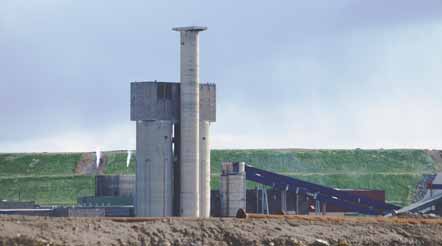
The new concentrator will be built on high ground above the tailings dam and to the south of the open-pit. An overland conveyor will deliver crushed ore to a covered storage building adjacent to the eastern end of the generally linear concentrator. The ore will feed to each of two milling lines at 2,200 mt/h (nominal). These will comprise one primary autogenous mill with gearless mill drive and one secondary pebble mill. Metso Minerals is supplying the 11-m (38-ft) diameter autogenous mills and secondary pebble mills and ABB the 22.5-MW gearless drive systems—a delivery valued at around SEK184 million (€20 million). Outotec’s Smedjebacken plant is supplying a regrind pebble mill and the engineering office in Skellefteå will be responsible for electrical and mechanical design. Another Skellefteå company, William Sale Partners, will perform some building design work.
The parallel copper flotation circuits will each have 13 x 160-m3 cells, although the supplier has not yet been selected, and the tailings will be depyritized from the start of the project. The plant will produce two tailings streams, one containing most of the tails and having a low sulphur content, the other with high sulphur. Molybdenum will be recovered in a separate flotation section and Boliden plans to extract gold by cyanide leaching and carbon-in-pulp recovery. However the gold plant is not covered by the present permit application and will be added later. The copper concentrate will be dewatered for transportation using three pressure filters although, again, the supplier had not been selected at the time of writing. These will be more cost efficient than the two rotary dryers in the existing concentrator.
At present, the concentrate containers are delivered approximately 20 km by road to the railway at Gällivare, from where they are railed to the smelter at Skelleftehamn. Boliden and the Swedish National Railway are in a joint project constructing a 3.5-km spur from the closest point on the rail line to a terminal near the tailings dam to eliminate the long road trips and rehandling. Sweco, a leading Nordic consulting company, was commissioned by the Swedish National Rail Administration to plan the new track connection. The assignment included the preparation of a railway plan and system documents for the new rail line and terminal. However, this project is not included in Aitik 36.
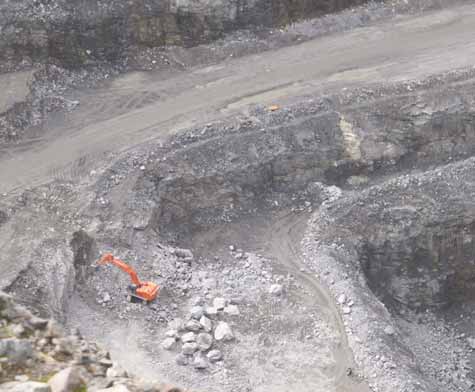
Even without this earnings stream the expansion will yield a significant improvement in Aitik´s profit and cash flow, according to Boliden. The return on capital employed will be well over 20%, even with a copper price 50% below the current level. Likewise, the expansion should reciprocally reduce the cash cost from existing levels of approximately $0.80/lb to $0.43/lb, not least because of the 10% energy cost savings resulting from the use of newer process technology. This will enable Aitik to generate positive cash flows with copper prices as low as the new cash cost level. This will, in turn, generate better preconditions for profitable operations, Boliden said, with positive cash flows, even during periods when metal prices are low. The project also offers a number of environmental benefits that will come in conjunction with the introduction of newer and more modern technology, including increased energy efficiency, better water usage, and reduced airborne emissions.
The Swedish contractor PEAB will build the concentrator, pump stations and some roads and open areas. “The contract with PEAB is worth around SEK670 million (€73 million),” said Jönsson.
Construction of the new concentrator and a new water pumping system is scheduled for completion at the end of 2009, with production scheduled to start in 2010, provided that the necessary permits have been obtained. Annual capacity will initially be 33 million mt, but this is expected to increase gradually, reaching full production of 36 million mt by 2014. At full production, contained copper output should average approximately 100,000 mt/y; gold production should double from existing levels of approximately 2 mt/y as a result of the overall capacity increase and the metal recovery offered by the new facility, and Boliden will start processing molybdenum.
Crushed Ore Supply
Both the re-siting of the concentrator
and the increase in mine output require
construction of a new crushing and conveying
system. The in-pit crusher station
supplying the current concentrator
has two gyratory crushers feeding to an
underground conveyor which discharges
at a transfer station in the eastern wall
of the pit. From there a second underground
conveyor system takes the ore to
a stockpile ahead of the concentrator,
ready for autogenous milling. This system
will be retained at least until the
concentrator is shut down and during
this period one semi-mobile in-pit gyratory
crusher will be installed in the
northern section of the open-pit and
another on surface, close to the stockpile
feeding the 3.5-km overland conveyor
to the new concentrator. The new
in-pit crusher will deliver product to
this stockpile via a new 3.5-km underground
conveyor system. The surface
crusher will handle ore delivered from
upper levels of future pushbacks in the
open-pit.
The hardware is to be supplied by Sandvik’s mining crushing and screening unit, part of the materials handling business. Vice President Christian Ottergren said the just over SEK800 million (€87 million) delivery includes two primary gyratory crushers, feeders and overland conveyors. The gyratory crushers will come from Sandvik’s alliance partner FFE Minerals as the contract preceded the launch of Sandvik’s own range of gyratory machines (See pp. 70). “The two mobile crushers will each have a capacity of approximately 8,000 mt/hour,” explained buyers Christina Richardson and Olov Boman, responsible for procurement from Sandvik. Boliden calculates that the higher investment cost for the 7-km-long conveyor belt transport solution is compensated by improved operational reliability and operating costs that are considerably lower than those for truck transportation.
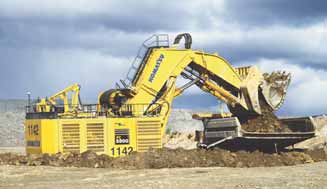
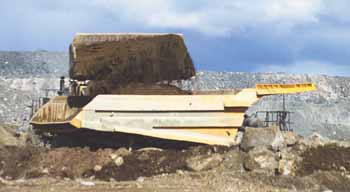
Skanska announced May 10, 2007, that it had been awarded a SEK460 million (€50.2 million) contract to build the concrete foundations for the crushers and overland conveyors, two ore storage facilities, a service truck workshop plus road and civil engineering work. Excavation for the in-pit crusher has already started and the construction work by Skanska Sweden´s special unit for industrial construction, IME, is scheduled to start in January 2008 and be completed in November 2009.
Bergteamet has started excavating the 3.5 km of conveyor drifts linking the new primary in-pit crusher to the new stockpile ahead of the surface conveyor. In addition to the tunnel system, the contractor will also build two large rock caverns for the transfer stations that are required to connect the different underground conveyors. The job is worth more than SEK100 million (€10 million). Bergteamet is using Atlas Copco and Sandvik drifting jumbos for the conveyor tunnels and a brand new Atlas Copco Rocket Boomer WE 3C30 for the transfer stations. The firm also has an Industriteknik Jama scaler on site and electrical supply units from the same company.
Meanwhile There’s a Mine to Run…
While securing the permits necessary
for the expansion to go ahead is crucial,
Richardson pointed out that his
main role is to make sure the mine and
mill keep producing at capacity during
project implementation. This will
require investment in the short-term,
which is not included in the project
budget, because some of Boliden’s
equipment fleet is rather old, with
many hours on the clock. The mine is
also working on optimization strategies,
such as improvements to blasting
practice that enabled Aitik to achieve
separate record ore (2.6 million mt)
and waste rock (1.9 million mt) blasts
this year. Safety is also a continuing
priority.
The Aitik pit comprises a smaller, shallower southern section expanded by one series of pushbacks and a larger northern section that is now 400 m deep, having been expanded by five completed pushbacks. Of these the fifth created the main current production area. Trucks haul ore from both pits to the existing in-pit crushing station located where the two sections join. The major Pushback 6 in the northern area is underway on the western side, where Boliden is using both a Komatsu PC 5500 electric-powered hydraulic excavator commissioned in February 2007, and a Caterpillar 994 wheel loader to strip overburden.
The production drilling fleet comprises four Bucyrus rotary blasthole rigs (49RIII, 49RH, 49R2, and 49R) of which two require immediate replacement. Pre-split drilling is done by NCC using Atlas Copco L8 rigs. While the PC5500 replaced a well-used Demag 485, a second hydraulic excavator in this size class is required and so is a new electric rope shovel. Although Aitik’s largest loading machines—two P&H 4100 shovels and a Bucyrus 495—are still relatively young, the mine is also using a B-E 295 dating from 1975 as a back-up machine and an even older Marion, although this is now only used occasionally to dig temporary tailings storage pits.
The truck fleet includes four Cat 789 haulers with about 100,000 hours on the clock—of which three are operating— plus 11 Cat 793B and C units of which six have been fitted with new frames and cabs by local Cat dealer Pon Equipment based in Boden near Luleå, and six 793Ds delivered by Pon last year. There are also six Unit Rig MT4000 diesel electric trucks previously used in Spain, of which four are operating with Caterpillar engines. Other mobile equipment includes two Cat D10 dozers, three 16H graders and five 980G wheel loaders. Caterpillar’s MineStar team in Brisbane, Australia, is working on new software configurations for the Aquila systems fitted to Aitik’s shovels, trucks, drills and two wheel loaders.
In the concentrator the main ongoing project is replacement of flotation cell tanks and refurbishment of the agitator systems where necessary.
…and an Expansion to Plan
Since the average copper grade in the
expanded mine will be only 0.29%, Aitik
must continue to compensate for low
grade through high productivity in the
mine as well as the concentrator.
Boliden said Aitik is already high on the
list of the world’s most productive copper
mines, with 43 mt/man-hour compared
with a global average of 15
mt/man-hour, but the expansion should
increase productivity to 55 mt/man-hour.
Clearly, doubling the amount of ore to be blasted, along with waste rock, will require a major expansion of the production drilling equipment fleet. And if Boliden does start producing aggregates for commercial purposes this may have implications for the fragmentation requirements for the waste rock. The pre-split drilling workload will also approximately double. Equally, the loading and haulage fleets will have to be expanded and Boliden has mentioned the possible use of ultra-haulers.
The final phase of the expansion will be the transfer of administration and maintenance to their new premises. The truck workshop should be in operation in fall 2009 as it will be needed to assemble whichever new truck fleet Aitik chooses and the whole transfer is scheduled to finish in 2015 when the new welding shop, administration offices and storage buildings are completed.
Work on the new access route linking the present main site entry road to the new premises has already started.
East of the pit geophysics and core drilling have identified a 31-million-mt resource to a depth of 200 m with potential mineralization below. At Salmijärvi, southeast of the pit, 40 milloin mt has been found down to 120 m, and at Aitik Östra near the northeast part of the mine 10 million mt has been drilled to 200 m. There are also other sulphide zones in the area. More grist for the mill.
LKAB: Higher Pellet Outputs From Lower Levels
Iron ore producer LKAB’s long-term project
to increase product deliveries from
23.3 million mt in 2006 to 30 million mt/y
continued to progress through the past
year, with significant impacts on the company’s mining and transportation
systems.
Of the 23.3 million mt delivered last
year,16.9 million mt were pelletized ore
but the project involves converting a higher
proportion of increased crude ore production
to blast furnace and direct reduction
pellets while maintaining deliveries of
sinter fines to customers for this product in
line with market demand. All this requires
developments at each of LKAB’s three
interdependent production centers,
Kiruna, Malmberget and Svappavaara to
optimize utilization of all the facilities, as
well as greater rail haulage capacity and a
new ship loading facility at Narvik, Norway.
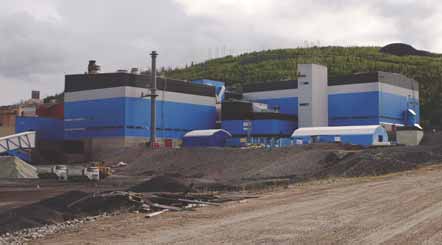
The magnetite ore source for these new pelletization plants, as well as the previously existing ones at Kiruna and Svappavaara, is the Kiruna mine, which will cease fines production. Malmberget ores, mainly magnetite plus some hematite, will be used in a previously existing pelletization plant on site and for the sinter fines product, with Sorting Plant 4/5 treating these ores and Sorting Plant 6 handling the ore coming from Kiruna for MK3 (although the Sorting Plants can each feed either pellet plant). Both mines must develop new lower main levels to produce sufficient ore.
Using Kiruna ore exclusively for pellets will allow a simplification of the mine’s crude ore production system. Although the orebody has a reasonably consistent magnetite grade, the phosphorus content is variable. At present, the ore is analyzed after mining and segregated in three flows according to the different process plants’ capacity for handling the phosphorus and alkali content of the ore. In the future, the mine’s new level will load and hoist only one ore grade. This will be suitable for the concentrator and pelletization facilities at Kiruna but will require reducing the phosphorus content for pellet making at Svappavaara. Project Leader Jan-Christer Gärde explained said LKAB commenced building a flotation plant at Svappavaara in February 2007, which should come on stream in 2008.
Malmberget Pellets
The overall project’s main event so far
was the start-up of the MK3 pelletization
plant at Malmberget’s Vitafors processing
complex on November 27, 2006, ahead
of schedule. The two-year construction
program also included a new grinding
and separation section in the concentrator
feeding the existing pellet plants on
the site and a new loading/unloading terminal.
Some 800 people from 140 companies
(including 40 from the Norrbotten
county where all three LKAB production
plants are located) worked on the
SEK2.6-billion (€284 million)project.
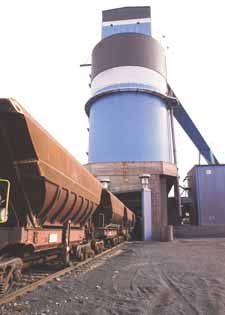
MK3 was conservatively designed with known equipment and process technology, including five 100-mt/h drum filters and five 110-mt/h prime raw pellet balling drums from Metso Minerals and the 105- m-long x 3.5-m-wide travelling grate sintering machine, process gas fans and air filtration equipment from Outotec (whose most recently announced contract is for a sinter plant for JSW Steel in India). The project also included the installation of digital control technology utilizing more than 2,400 instruments. One control room now operates both MK3 and the BUV from a bridge between the two, effectively creating one plant with two grates.
A key feature of the new plant is the fuel consumption, which averages 5 liters oil per ton pellets compared with approximately 15 l/mt at conventional hematitebased plants. Improvements in pellet production technology have already reduced LKAB’s energy consumption rates—such that the firm required 3,182 GWh to make 16.9 milloin mt pellets in 2006 compared with the 3,053 GWh needed to make 15.1 million mt in 1998—and MK3 will further reduce energy consumption per ton. The new plant also has a very thorough flue gas cleaning system built-in that accounts for the plant being volumetrically larger than the BUV.
The loading/unloading terminal has two 8,000-mt product load-out silos that can load around 4,000 mt/h to a moving train. The unloading section handles incoming ore from Kiruna and additives.
Mine Developments
Unlike Kiruna, where the magnetite ore
occurs in one long steeply dipping sheet,
Malmberget is working multiple flatterlying
orebodies from levels extending down
to 1,000 m. The mine currently produces
14 million mt/y of raw ore, of which
13%–15% is hematite. Together with the
ore delivered from Kiruna, this is currently processed to yield 9.7 million mt/y
products,
of which 6.6 million mt are pellets
and 3.1 million mt are fines.
The 1,000-m level was opened in 1999, with large truck haulage to a crushing station. The product is then conveyed via the old crushing station to the Vitafors skip hoisting shaft on the 815 level. In addition two ore passes feed directly to the crushing station. Subsequently, the Printzsköld ore between the Johannes and Josefina orebodies has been developed at 780 m and the 1,000-m level has been extended to mine a newly developed section of the Fabian orebody.
Even so, a new level at 1,250 m will also be required by 2010–2011 to meet planned production targets. Although a final go-ahead from the LKAB board is dependent on resolving some remaining legal issues, LKAB did extensive work during 2006 on the initial mechanical dimensioning of the necessary infrastructure and started development of critical elements such as an access ramp and ventilation shafts. This year rock stress measurements have been conducted at the sites for the planned crushing and hoisting installations. Similar steps have been taken at Kiruna where a new main haulage level must be developed at 1,365 m.
The 1,250-m level project will retain the 1,000 to 815 level conveyor connection and will be accessed by ramp. A new crushing station with two primary crushers will load a blind shaft skip hoist to lift the ore from the 1,250 to the 1,000-m level. The ramp development has already been permitted and, said Lundgren, reached the 1,250-m level in June 2007.
Technology introductions at Malmberget include slot drilling with an Atlas Copco W6C production rig and automated haulage using Caterpillar’s MineGem technology. LKAB is also trying to improve and economize blasting technology— the company used 16,200 mt of explosives in 2006.
The slot drilling version of the W6C rig developed specifically for LKAB (E&MJ, October 2006, p.44) is equipped with a Wassara water-powered pilot drill and a Wassara 120 ITH slot hammer with Secoroc tooling developed by the manufacturer in close collaboration with LKAB. The W6C operator first drills a pilot hole to the top of the ore to be caved, then switches to the slot hammer. This has a bit to which is attached a guide tube that the operator inserts in the pilot hole so that the W6C will drill the first slot hole precisely parallel to the pilot hole. This process is repeated until all the holes required for the slot have been drilled. The operator then drills a number of conventional holes in a rectangle around the slot after which the operator withdraws the W6C and one of the mine’s automated W469 rigs comes into drill the fans under remote operator supervision via a cable connection.
Atlas Copco Product Manager Patrik Ericsson said that, although the slot drilling concept is simple, developing the equipment to carry it out raised a number of problems that had to be solved. The manufacturer has sold two slot drilling versions of the Simba M6C ITH rig to customers in Brazil. Meanwhile the two W6C fan drilling rigs at Kiruna operate autonomously and can be monitored by the operators using a remote desktop via Atlas Copco’s Rig Remote Access (RRA) technology, Ericsson added.
A new blast control system has been introduced that results in better, smoother contour blasting, according to the company. LKAB is also focusing on ways to reduce the amount of nitrogen left in the blasted ore as a result of incomplete detonations and says that new technologies tested at Kiruna have produced positive results.
Together with Caterpillar engineers from Melbourne, Australia, Malmberget has been testing the MineGem automation system using the Cat R2900G Extra loader. Trials started in February and should be completed in November, whereupon the results will be evaluated.
21st Century Transport
It was the hard-won, late 19th-century
development of the “Ore Line” connecting
Luleå on the Gulf of Bothnia, Gällivare and
Kiruna in the Norrbotten orefields and
Narvik on the ice-free Norwegian coast that
made large scale exploitation of the longidentified
metals resources possible.
Technically this single track line seems to
have served its purpose remarkably well
through the years, taking on haulage of
concentrates from Boliden’s Aitik mine in
1968 in addition to increasing iron ore
shipments.
However, freight pricing became an issue between LKAB and the rail authorities, especially during the 1980s when the mining company believed that the high charges compounded market difficulties, contributing to heavy losses at that time. The state intervened and in 1996, Malmtrafik AB (MTAB) and its Norwegian counterpart Malmtrafikk AS (MTAS) were established, with LKAB holding a 51% interest in each, enabling the mining company to take control of ore traffic. Later, LKAB gained full control of these companies and was able to initiate a series of operational improvements while reducing haulage cost per ton. In 1999 the firm’s rail transport bill was about SEK400 million (€43.7 million) compared with more than SEK2 billion/ y (€128 million) in the 1970s in equivalent value terms.
During 2004, LKAB took a significant modernization step, buying new IORE locomotives built by Bombardier that are able to haul longer trains. These replaced some of the smaller Dm3 locos in use, although some of these are still working. Then, in 2006 the foundations were laid for a future logistical structure with increased payloads and shorter cycle times for the trains that will significantly increase the line’s capacity. The essential step in this program is upgrading the track to handle 30 mt minimum axle loadings and lengthening the sidings where the trains pass each other to accommodate longer trains.
Terminal improvements will also contribute to faster cycling of the trains. The rail yard at Kiruna will be rebuilt for SEK125 million (€13.6 million)with a new terminal structure that allows loading of the trains at surface level. Four of the seven existing tracks will be extended to handle longer trains. A new receiving facility and track for discharging trainloads of additives has already been built and a de-icing plant is being installed.
With a view to making optimal use of the upgraded track, LKAB took delivery in March 2006 of 70 of a pre-series ore car with a 100-mt payload at the 30-mt axle loading. These have proved sufficiently satisfactory that the company decided to order three more sets, signing a framework agreement for 680 cars with a consortium that includes Kockums and the LKAB subsidiary KGS Mekaniska. Delivery of this production series and additional locomotives started in December 2006 and 10 full train sets will be operational by 2010. Hauled by locomotives with a tractive effort of 2,100 kN, said to be the most powerful in the world, these trains will make two journeys per 24 hours. As in present practice they will backhaul additives for pelletization etc, including olivine and quartzite from Narvik and limestone and coal from Luleå.
While LKAB is building a new terminal at Narvik, the ship loading facility at Luleå is also relatively new. Faced with a very big investment in cover structures for the previous terminal in the Svartön area required by the environmental authorities, the company built a new one closer to the open sea at Sandskär, which opened in 1996. This terminal is environmentally friendly, LKAB said, and is scaled to load the ships and pusher barges used to supply steelworks on the Baltic coast. Major customers include SSAB at Oxelosund and Ruukki at Raahe.
Finland’s Kemi Goes Underground
The Outokumpu Tornio Works (OTW)
operates a unique, fully integrated stainless
steel production system, with the
Kemi chrome mine in Keminmaa and the Ferrochrome Works, Steel Melting Shop,
Hot Rolling Mill and Cold Rolling plants
in Tornio, just 30 km away at the mouth
of the Tornio River, which is the border
between Finland and Sweden. The location
of the chromite deposit, close to the
sea, hydroelectric power potential and a
good harbor site, was a major reason for
the development of these facilities which
are central to Outokumpu’s strategy
aimed at stainless steel market leadership.
The company has expanded capacity
at Tornio and OTW now employs
2,300 people, of whom 130 work at
Kemi assisted by around 100 contractor
personnel. A new investment program
totaling €1.1 billion will expand total
slab capacity from 1.75 to 2.75 million
mt/y and coil rolling capacity from 1.2 to
1.9 million mt/y. In September 2007,
Outokumpu announced it will invest
€550 million in stainless steel special
grades capacity at its Avesta Works in
Sweden.
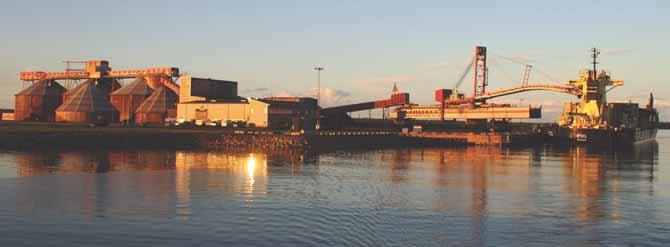
Transition Achieved
In September, Outokumpu’s Jyrki
Salmi, manager–mining, and Heikki
Pekkarinen, manager–mineral processing,
reviewed the project’s progress.
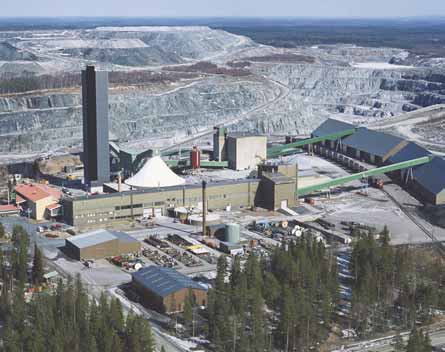
Grade control has been maintained in the underground mine, using various data streams. Deliveries to the ferrochrome smelter have been maintained, typically comprising about 210,000 mt/y of 10-120 mm upgraded lumpy ore with 35% Cr2O3 and around 385,000 mt/y of fine metallurgical grade concentrate grading 45% Cr2O3.
The ventilation, dewatering, crushing and hoisting infrastructure installed have performed as intended. Following completion of the main workshop on the 500 level in 2006, all maintenance of Outokumpu mobile equipment is carried out here, assisted by an Atlas Copco specialist. The small workshop on the 115 level is now used by Kemi’s service contractor and the one on the 350 level by the loading and haulage contractor.
The mobile production equipment units selected have generally performed as expected, including the Atlas Copco RRA (remote rig access) system, but it has been necessary to acquire some additional units to maintain the development rate required. Kemi will continue to use state-of-the-art technology.
Last but not least, the fast communications network and single master database created by the Intelligent Mine Program has been extended. In 2005, control of the underground crusher and the hoisting system was integrated with a new mineral processing plant control room and a new process control system, again from Siemens. And this year the underground wireless network was completed. Kemi has also been developing more ways to exploit the data processing opportunities the technology presents, in particular a visualization system.
However, explained Salmi and Pekkarinen, this does not mean everything has been entirely straightforward. The challenges that had required very careful prior planning of the switch also needed a flexible approach during the execution phase of the project, with economic factors also contributing to some modifications of the original strategy.
Grade Control and Mining Methods
Grade control and mineability were key
factors considered in planning underground
mining at Kemi. Although ore
reserves are abundant the grade averages
only 24%–26% Cr2O3, which is
rather low in comparison with the plus-
40% material mined in South Africa, for
instance. So, international competitiveness
requires that the Kemi mineral processing
plant upgrades the ore as much
as is feasible as well as supplying material
of very consistent quality to the
smelter. This in turn means ensuring
very consistent feed from the mine to
the plant, which utilizes physical separation
techniques to produce the lumpy
ore and metallurgical grade fines. The
geometallurgical and rock mechanical
characteristics of the five orebodies that
make up the 1.5-km-long ore zone (with
a dip of 70° NW) now being mined
below the main open-pit vary quite
widely, so planning the stoping schedule
to achieve the required feed grades
needs very careful attention.
As in the open-pit, Kemi can use intensive wire line diamond core drilling, now with a new Diamec U6APC rig, to determine ore boundaries, with additional sludge color information from blasthole drilling. All core is analyzed by OMS-logg down hole logging, and automated microscope image analysis is used for establishing grain size distribution. Five ore zones can still be differentiated along the 40-m-wide (average) orebody and can yield reasonably consistent ore types. But a major difference is that, whereas each 60,000-mt ore blast in the open pit provided sufficient tonnage to be treated selectively at the concentrator, minimizing feed variation and maximizing process stability, this is not possible with the bench cut-and-fill (BCF) mining method used in the underground mine. Designed to cope with weak hanging wall rock and very variable fragmentation, this technique typically yields only 7,000 mt per blast.
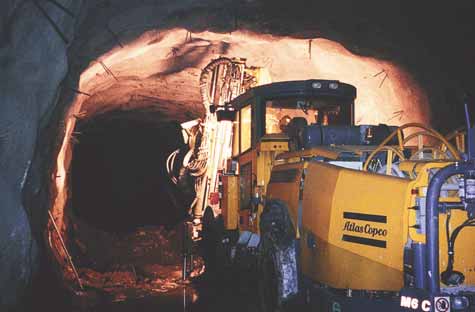
The BCF technique initially adopted has been continued and mining of secondary stopes started in 2005. One variation is that some stopes are shorter than originally envisaged. The Atlas Copco Rocket Boomer L2C drifting rig normally drills 25- to 30-m2 faces with 45-mm diameter holes—60 to 72 per face— using 18-ft drill steel. The charging and blasting contractor uses site-sensitized emulsion for development and production blasting, which is delivered by custom- built Scania trucks provided by Outokumpu. However, development has proved to require 5,300 m of drifting a year and in December 2006 Kemi added a Rocket Boomer E2C18 rig, followed by continuous two-shift, seven-day rotation rather than the previous five-day week. Working a seven-day schedule will continue as long as the need for drift meters lasts, that is until the end of year 2008.
The Simba M6C drills 51- or 64-mm diameter downholes in fans 2 m apart. The contractor charges these holes with emulsion explosive, at 100 g/mt, and blasts using Nonel caps. Three rings yield 7,000 mt ore in one blast. The mine also added a second production drilling rig, in this case a Simba L7C, to the fleet plus a Boltec LC rig, in this case with a screen placing arm for use in the stope drives. A new Diamec U6 core drilling rig started work in February 2007, replacing the long serving 264, and a Normet Spraymec 9050 started work in April 2007, and the 1050 will be held in reserve. The haulage and loading contractor’s fleet has also expanded, additions including two Caterpillar R2900G LHDs and a Cat 966E wheel loader as well as new haul trucks. Some 70% of loading is now by remote line of sight control and tablet PCs are being fitted on the loaders for data recording and reporting.
BCF stoping now extends from the 500 m level up to 450 m, the 425 and 400 levels are already being prepared for mining and development work has reached the 375 m level. From 1999, when development started, until July 2007, BCF delivered 2.26 million mt ore grading 26.4% Cr2O3.
From 2005 until this year, Kemi has also tested sub-level caving (SLC) with uphole drilling, which could be done with the existing equipment fleet. These trials were carried out in the upper levels at the western end of the mine, the ore being trucked out to the surface crushers. The first trial on the 210 level has not worked well, partly due to the behavior of a permafrost layer under the pit backfill and above the stopes, but results in the 225 level have been better. SLC suffers ore losses of 35% and dilution of 20%, compared with 30% and 13% respectively for BCF, and the ore averages only 25.3% Cr2O3. But a high level of ore security is vital for the integrated production system and SLC does provide a fallback, for instance if the hoist is out of action, and Kemi has drilled a reserve production option on both levels. The mined output from the trials totalled 237,875 mt, of which 185,000 mt is being processed and stored this year together with the 965,000 mt from BCF and 161,000 mt from the open-pit stock.
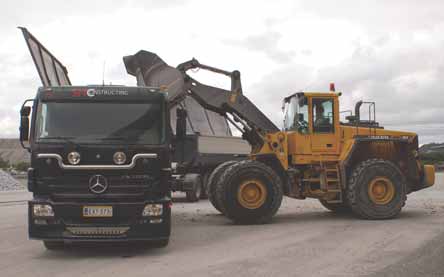
Although the process has not changed much as a result of underground mining, some new equipment has been introduced. The analyzers on conveyor feeding the Heavy Medium Separation plant have been replaced and within the plant the old drums have been replaced by new ones made to Outokumpu’s design by a local manufacturer. New Roxon screens are programmed replacements. Lumpy waste from the HMS process is now being used as a component of backfill. In the concentrator two of the Reichert Cones were replaced by Roche spirals in October 2003 which achieved the intended aim of increasing the concentrate grade. Payback on the spirals investment took 18 months on a 0.7% Cr2O3 increase in grade, Pekkarinen said.
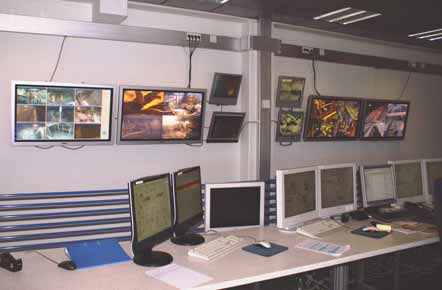
The present tailings storage will fill up during 2008 and a new, 1-km2 seventh pond is under construction, covering 70 years operation at current rates. The system recycles 97% of the water used, with the rest being drawn from the Kemi River.
Another significant change has been a switch from rail to truck transportation of concentrates to Tornio. In 2005, the haulage contract came up for renegotiation and trucking proved to be both cheaper and less polluting. Since the start of 2006, Mercedes Benz truck/trailer units with rotary dumping bodies have been taking concentrates to the ferrochrome smelter under a five-year contract. The units haul 40 mt, just under the Finnish limit for road transport, at a maximum speed of 80 km/h, which gives a cycle time of two hours. A truck leaves Kemi every 30 minutes and the fleet works 24 hours per day, six days per week. Pekkarinen said that the trucking contract has so far been very successful, with no accidents and no missed deliveries. Another carrier is presently trucking 300,000 mt of waste rock to a marine wind farm project.
Networking Progresses
Jyrki Salmi said that the operation’s data
storage/retrieval and communications network,
devised under the Intelligent Mine
Program, has found progressively more
use as the degree of integration has
increased. The aim is to transmit as much
of the operation’s information as possible
via the network, for example when preparing
for the morning meetings.
Today the central KaTTi web server and Siemens IT Historian database are linked to two Ethernet LANs, one serving the mine and the other the processing functions plus the Engineering office. The Process LAN connects GUIs in the control room, heavy media separation plant and engineering office with ISO/OSI stations at the underground crusher, surface crushing station, HMS plant, concentrator (two, one of which controls the pump station) and the underground pumping stations. The underground LAN connects two Simatic S7-400 and an ET200M distributed I/O and operator GUIs. The control room is also linked by optic fiber to the ABB Advant AC110 hoisting control system, which is itself linked to three S800 distributed I/O sets underground.
Installation of the underground fiber optic W-LAN throughout the mine was completed this year. Supplied by Cisco but installed by Outokumpu, the W-LAN provides a number of services, including surface to mine telephone communication, a means of locating personnel and equipment using base stations, and data transfer between the mine and process plant production operations and the main database. High-speed data transfer between survey total stations, Kemi’s Surpac 3-D orebody model and linked Outokumpu mine scheduling software, and the RRA system on the Atlas Copco equipment allows these machines to become more autonomous in operation. All drill-monitored data, including measure- while-drilling information, is transferred to the database.
A major new way of utilizing the network is a 3-D visualization package developed for the mine by Finnish company CyberCube Oy and introduced this year. This powerful tool enables key personnel to right click up the information held on the database in a form that allows the location of a particular piece of equipment such as a pump, its status, maintenance history and all the data needed to create a work order. A new work order can be generated, showing the location of the machine in, for instance, a named drift and directions as to where to move it. Alternatively a machine’s active work list can be updated on a shift by shift basis via the database. The system will also display production targets and achievements for each stope or drive.
Other improvements include the replacement of the Actionet leaky feeder telephone system by a VoIP (Voice over Internet Protocol) telephone system, which was completed in July 2007. This will allow, for example, alarm text messages to be sent to every miner and contract person underground.
Ways to Stay on Track
Outokumpu is certainly thinking longterm.
Phase 1 of the underground mine
plan covers a period of 25 years at the
current mining rate and the Phase 2 ore
block contains a similar amount of ore.
But the Kemi team knows it will have to
stay on its toes to remain a competitive
concentrates supplier for Tornio.
This is what lies behind the decision to replace key production equipment relatively early, a move that has caused surprise in some quarters including Atlas Copco—presumably pleasant as the move does not reflect any dissatisfaction with the units in place. Salmi explained that the new Boltec LC with screen arm due to arrive in December this year is needed to keep the drifting cycle of stope drives as fast as possible. The first Boltec, without this arm, will be retired. The new Cabletec LC and Simba L6C due to arrive at about the same time are straightforward replacement machines, the objective being to keep performance levels as high as possible and maintenance (and thereby maintenance workers) to a minimum. The policy also emphasizes the mine’s commitment to providing its miners with the best equipment, which they respect, said Salmi. The new Simba is fitted with Atlas Copco’s rod extraction system and will use 64 mm bits.
Kemi is working on the use of electronic caps and remote blasting technology with Davey Bickford and Orica technology and is also working on further steps toward autonomous operation, both in drifting and stoping. ABC Total has been taken into use both in face and long hole drilling. Further implementation of the visualization system will be carried out and new applications of the IT network studied.
Power Security Partnership
All of the northern mining companies are
highly dependent on electricity. So they
are worried that long-term trends in the
cost of fuel for the existing generating
capacity may push the electricity prices
they have to pay sharply upwards, eroding
the competitiveness they have worked
so hard to achieve.
In June 2007, Outokumpu announced its participation in a new Finnish power company Fennovoima Oy, a consortium consisting of Outokumpu, Boliden, Rauman Energia, Katternö and E.ON. Fennovoima's aim is to construct a new 1,000- to 1,800-MW nuclear power plant to meet Finland's increasing need for electricity. Operation of the plant is planned to start between 2016 and 2018. Fennovoima will produce electricity for its owners' needs at production cost. Each owner will be allocated a share of the plant's capacity that is proportional to its ownership in the company. By participating in Fennovoima, Outokumpu's aim is to secure a significant portion of its electricity needs in years to come. The target is to have up to 150 MW of the new nuclear power plant's capacity. This translates into some 1.2 TWh of electrical energy per year, more than half the Tornio Works' current annual requirement.